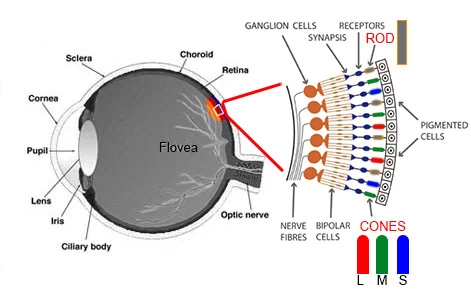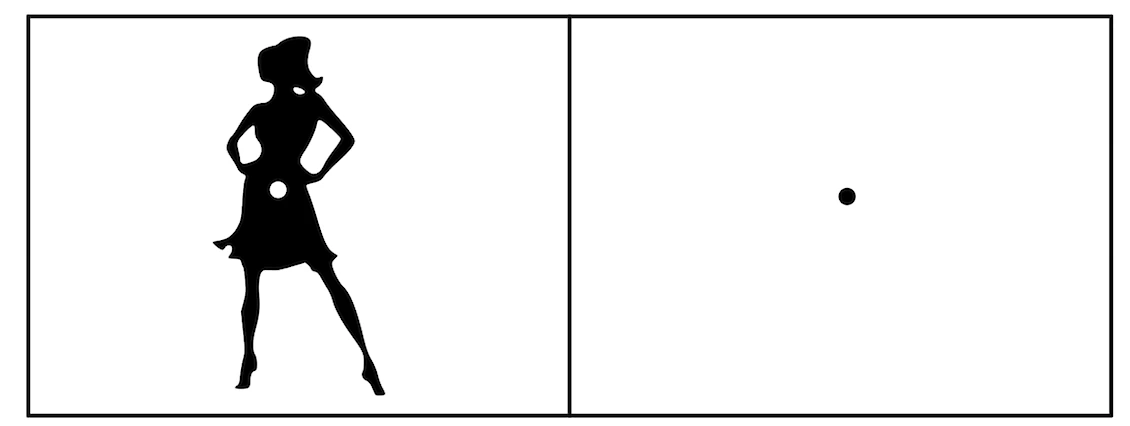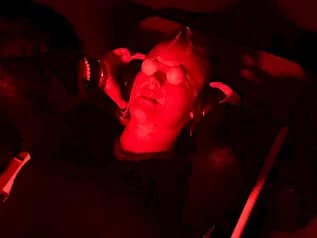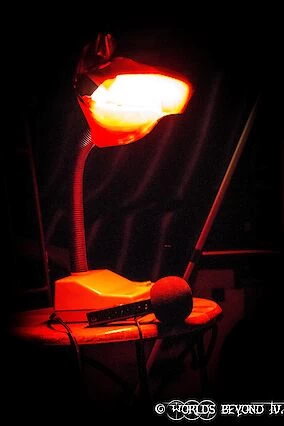

Dark adaptation and red Light
When attending my first paranormal tours many years ago now, I noticed that many places were lined with lanterns that used red light bulbs. When I asked people "Why red?" while some said it was a great colour to use as it wasn't as harsh on the eyes, others said they used it because it adds to the creepy vibe. Like many things, red light has found its way into paranormal investigating so let's look in much more detail at how and why it could be useful as well as what light itself does to our eyes.
How do our eyes adapt to light changes?
I don't know about you, but when I was younger, I was told that if I ate a lot of carrots it would improve my vision at night. While this is an old wives tale, there is actually a process that our eyes go through to adjust to the changes in light. Adaptation is what is referred to when the retina which is inside the eye adjusts to different levels of light. We are all capable of a certain degree of natural night vision. Think about when you are in a paranormal investigation and you are in a room and then turn out the lights. In the beginning, it seems like you are in pitch-black darkness. The longer you are in the room, your eyes begin to adjust and you can start seeing items in the dark a lot more clearly. Typically it can take a person 20 - 30 minutes to properly adjust, however it is said that it really takes 2 hours for the process to happen properly. When our eyes are not properly adapting to the light, it can cause us to maybe see things that aren't there or even mistake a cupboard in the corner for something else.
In simple terms, if we are exposed to bright light, our iris becomes smaller so that less light is let in. When it is dark, the iris becomes wider and larger to let in more light. Did you ever do a trick growing up where you would stand in front of a mirror and turn the light off and on to watch the size of your iris change? I remember doing this in Science. While this is the physical part we can see, there is a chemical change that also happens inside our eyes. The retina inside our eye detects these changes in light through what is called cones and rods. There are three types of cones that are sensitive to different wavelengths of light. This is how we can detect colour. Sometimes, a person's cones are not functioning as they should and this is where colour blindness can come in. There are four main types of colourblindness that affect approximately 8-10% of the population. Some people may not be able to receive red light, others blue light which some can only see in Black and White.

Image Source: http://www.theinkrag.com/colour_blindness/monochromacy.html
The rods in our eyes are the ones that are sensitive to light. They don't interpret colour, only light. If our eyes are exposed to bright light, the cones and rods become overexposed and often we will see a large flash of light, much like you see on an overexposed photograph. This can also cause a person to see what is called an afterimage. This is something I have written about in detail in my book Stuff Paranormal Investigators Need To know. When you stare at a black image for a prolonged period of time and then look at a white piece of paper, you can see the image floating down. It just shows us what happens when our eyes are trying to adjust. It can make us see things that are not there. Try it! Stare at the white dot on the left image for 30 seconds. Now move your line of sight to the black dot on the right. You will see a 'lady in white' slowly float down.
 Image Source: Stuff Paranormal Investigators Need to Know Volume 1
Image Source: Stuff Paranormal Investigators Need to Know Volume 1
While the cones reset really quickly, it takes the rods a lot longer to reset and adjust to the change in light. As we get older, our eyes degenerate. We all have varying levels of eyesight and different types of light have different luminosity which means that the time it can take to adjust to the dark is different for each person based on the health and condition of their eyes plus the type of light. It is different for example going from a Sunny room to a dark room as opposed to having a fluorescent light on which is then switched off. Not everyone has the time to spend 2 hours sitting and wait for the process to properly adjust to light changes. This is where the red light can come in to assist.
Red light for dark adaptation
Every time we expose ourselves to bright light, we have to go through the process to readjust again. Think about being on a paranormal investigation even with just a flashlight. Every time you turn that on, you are essentially starting the dark adaptation process, again and again, each time you switch it on and off. You are never really giving your eyes the chance to properly adjust. If they are not properly adjusted, this is where you may think you are seeing shadows or that items are moving when they aren't. The rods in our eyes are a lot less sensitive to red light meaning that if we used a proper red lantern or red flashlight during an investigation, we are helping our eyes to properly see in the dark without compromising our eyesight. You are essentially setting a baseline of light for the night.
Think of the old darkrooms that photographers used. To process a photo on photographic paper, it cannot be exposed to light as the paper is sensitive to light and would become overexposed. Did you ever accidentally open the back of a camera and expose a negative and it ruined the negative with just a large flash of light? This is pretty much the same kind of thing. In order to process the photography the old fashioned way in a dark room, they needed to be able to see in the darkroom so they would use red light. The red light allowed them enough light to see, but it wasn't bright enough to expose the photosensitive paper as quickly.
Red light in the Ganzfeld experiment
One of the more famous ways red light is associated with the paranormal is during the Ganzfeld experiment.

I know I myself used to ask why red light? During the experiment, the participant is to keep their eyes open while looking through cut in half ping pong balls. The colour of the light is said to have no effect on the experiment itself as people have also used blue and green light, but the red light was used so as not to damage the cones in a person's eyes. It makes sense. If you are lying in a chair, it isn't a good idea to be staring at a bright light for 30 minutes. You could cause permanent damage.
If you want to read more about the Ganzfeld experiment, check out my article here.
Red light for night photography & sky watching
Red light is often used for photographers to take photographs in low light conditions or in the dark. It helps them to navigate to the spot they need to be, make the adjustments on their cameras and shoot without compromising their eyesight. Some, however, prefer to sit outside and let the process happen naturally. This is something that would be highly beneficial while sky watching for UFO activity. Again if you are constantly using flashlights, your eyes have to go through the process of adapting to the light change again and maybe you aren't seeing the sky as clearly as you could be. Maybe you are missing something? It could also make you see things moving when they are not. This is where using red light can really help you navigate your way around and to 'see' in the dark without exposing your eyes to bright light. Otherwise, sit outside and let your eyes adapt naturally to the darkness. You will gradually find the night sky becomes brighter and brighter.

Ultimately, red light also adds to the 'creepy' vibe of a paranormal investigation. The colour red makes a person's heart rate rise and they can feel a rush of adrenaline or excitement. It is also a colour often associated with danger. Add in creepy locations that are supposedly haunted and the colour red can change the feel of the entire room. It adds to the experience in a lot of ways. While the red lights are used to help you see in the dark, they are also to set a mood and invoke those feelings.
The best thing you can do is to let your eyes naturally adjust. If you don't have time to sit and wait for that to happen, a red light is better than normal light. It should be a red globe and not just a white light coloured in cellophane and this is not true red light which means our eyes are still being exposed to light that we have to adjust to. Our eyes can deceive us in many ways and we never know if we can trust what we are seeing. Turn off the flashlight, watch and wait. This is when you will start to see things as they really are. Who knows what you will see?
References:
https://www.scientificamerican.com/article/experts-eyes-adjust-to-darkness/
http://www.chm.bris.ac.uk/webprojects2003/white/light_and_dark_adaptation.htm
https://www.sciencedirect.com/topics/agricultural-and-biological-sciences/dark-adaptation
https://www.ncbi.nlm.nih.gov/books/NBK11525/
https://archive.briankoberlein.com/2015/04/08/blinded-by-the-light/index.html
http://www.theinkrag.com/colour_blindness/monochromacy.html
If you enjoy LLIFS, consider buying me a book (otherwise known as buy me a coffee but I don't drink coffee and I LOVE books). Your donation helps to fund the LLIFS website so everyone can continue to access great paranormal content and resources for FREE!

Top pages with similar subjects
Don't forget to follow the Facebook page for regular updates
Join the mailing list to receive weekly updates of NEW articles. Never miss an article again!
Buy the latest and past issues Haunted Magazine
Check out the books written by LLIFS
Comments
-
Jon 4 years ago
Thanks for taking a scieney approach to this, it's very refreshing! However, a quick question... why not just avoid the entire problem and investigate with the lights on? Quoting your own blog "Our eyes can deceive us in many ways and we never know if we can trust what we are seeing", so why don't we just investigate with the lights on in order to eliminate situations where shadows and such could play tricks on our eyes in the first place?
-
LLIFS 4 years ago
Excellent Point!!!! Although there may be circumstances where this is not possible especially if a person is outdoors or in a location with no electricity, but they could also do it during the day ????
-